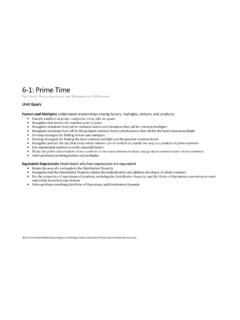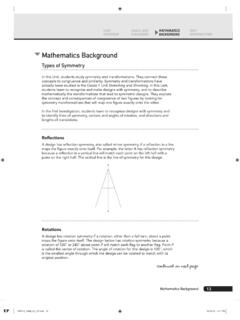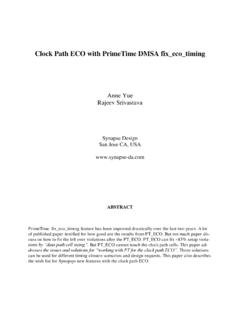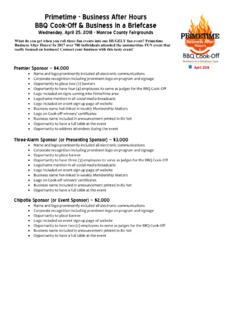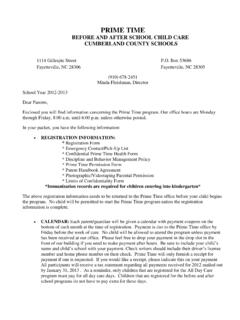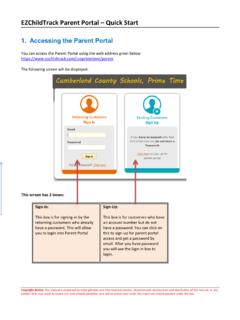Transcription of Prime Time: Homework Examples from ACE
1 Prime time : Homework Examples from ACE Investigation 1: Building on Factors and Multiples, ACE #8, 28 Investigation 2: Common Multiples and Common Factors, ACE #11, 16, 17, 28 Investigation 3: Factorizations: Searching for Factor Strings, ACE #6, 27, 43 Investigation 4: Linking Multiplication and Addition: The Distributive Property, ACE #7, 24 Investigation 1: Building on Factors and Multiples ACE #8 In the following Factor Game, some of the scores are missing on the tally sheet. a. In Round 1, Cathy chose 24. Keiko scored 36 points. Make a game board. Mark Cathy s choice and Keiko s factors.
2 B. In Round 2, it is Keiko s turn. Cathy scored 21 points. What number did Keiko pick? c. In Round 3, it is Cathy s turn. Keiko scored 9 points. What number might Cathy have picked? d. In Round 4, it is Keiko s turn. Keiko chose 30. What did Cathy score? e. In Round 5, it is Cathy s turn. What is Cathy s best move? Explain your choice. In Problem , students play The Factor Game. The purpose of this game is to practice finding factors of whole numbers and to learn some interesting things about numbers. A copy of the board used for the factor game can be found in the student book. a.
3 Cathy chose 24, so Keiko would mark all the proper factors (all the numbers you can evenly divide into 24, except 24. 24 is a factor of 24, but a proper factor are only those factors less than the original number). The proper factors of 24 are: 1, 2, 3, 4, 6, 8, and 12. Adding these up will give: 1 + 2 + 3 + 4 + 6 + 8 + 12 = 36 (Keiko s score). b. Keiko picked 28. The proper factors of 28 are: 1, 2, 4, 7 and 14. The numbers 1, 2, and 4 are already marked, so Cathy s score is 21 by adding the two remaining factors 7 and 14. Here is the game board at this stage in the game: c. Cathy picked 18 or 27.
4 Keiko scored 9 points by circling 9 (the factor of 18 or 27 that is not already circled). d. Cathy scores 30 points for 5, 10, and 15, (the factors of 30 that are not already circled). e. The only numbers remaining with uncircled factors are 22 (11) and 26 (13). Cathy should choose 26 because she will score 13 more points than Keiko. Investigation 1: Building on Factors and Multiples ACE #28 a. What type of number has exactly two factors? Give Examples . b. What type of number has an odd number of factors? Give Examples . c. Are there any Prime numbers that are also square numbers?
5 Give an example or explain why not. a. Prime numbers are special numbers that have only two factors, 1 and itself. Examples : 2, 3, 5, 7, 11, ..Two is the only even Prime number because all other even numbers have at least three factors, 1, 2 and itself. The number 1, is not a Prime number because it has only factor, 1. b. Square numbers have an odd numbers of factors. Examples : 1, 4, 9, 16, 25, 36, .. If you multiply a whole number by itself you will get a square number. These numbers are called square numbers, because to find the area of a square you multiply the lengths of the two sides together, which are the same in a square.
6 C. No Prime number is also a square number. Students might use parts a and b to reason that because Prime numbers have exactly two factors (from a) and square numbers have an odd number of factors (from b), you could never have a Prime number that is also square. For square numbers that are 4 or larger, you can also reason that square numbers have at least three different factors, 1, the number you multiply by itself to get the square number ( 2 x 2 = 4), and the square number itself. Investigation 2: Common Multiples and Common Factors ACE #11 Find two pairs of numbers with the given number as their least common multiple.
7 36 In Problems and , students work on Least Common Multiples, often abbreviated as LCM. The Least Common Multiple of 2 or more numbers is the lowest multiple that is common to these numbers. For example the Least Common Multiple of 5 and 6 is 30 because 30 is the lowest number that is a multiple of 5 and 6 (note: there are other common multiples, such as 60, 90, , but there is only one Least Common Multiple). Multiples of 5: 5, 10, 15, 20, 25, 30, 35, Multiples of 6: 6, 12, 18, 24, 30, 36, 42, Students might conjecture (making an educated guess) about how to find the LCM of two numbers.
8 For example, students might think that you can just multiply the two numbers together to get the LCM (which worked for 5 and 6). However, this does not always work, such as the Least Common Multiple of 5 and 10, would be 10 not 50. To solve #11, students might try to start with factors of 36. By doing this, it will ensure that 36 eventually shows up as a multiple. For example 4 x 9 = 36, so Multiples of 4: 4, 8, 12, 16, 20, 24, 28, 32, Multiples of 9: 9, 18, 27, So 36 is the LCM(4, 9), because 36 is a common multiple to both lists, and is the least of the common multiples. Another possible answer is 36 and 1.
9 Note: multiples of 1 would be all whole numbers, and multiples of 36 start with 36. Students should be cautious to not simply choose the two numbers that multiply together to produce 36, as it may not produce the Least Common Multiple. For example: Multiples of 18: 18, 36, Multiples of 2: 2, 4, 6, 8, 10, 12, 14, 16, 18, 20, 22, 24, 26, 28, 30, 32, 34, 36, Although 36 is a common multiple, 18 is actually the least common multiple. Investigation 2: Common Multiples and Common Factors ACE #16, 17 List the common factors of each pair of numbers. Then find the greatest common factor of each pair.
10 #16) 18 and 30 #17) 9 and 25 Similar to finding the Least Common Multiple, the Greatest Common Factor (often abbreviated as GCF) of 2 or more numbers is the largest factor in common to those numbers. For example, the Greatest Common Factor of 8 and 10 is 2 because 2 is the largest number in both lists of factors. Factors of 8: 1, 2, 4, 8 Factors of 10: 1, 2, 5, 10 #16) The factors of 18 are: 1, 2, 3, 6, 9, 18 The factors of 30 are: 1, 2, 3, 5, 6, 10, 15, 30 Common Factors of 18 and 30 are: 1, 2, 3, 6 Because 6 is the largest number that is a common factor, this means that 6 is the Greatest Common Factor of 18 and 30.
